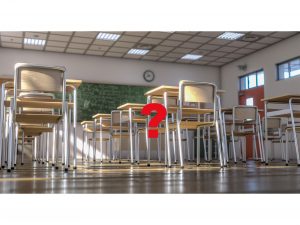Teaching in a time of COVID
One thing that you can say about teaching in a time of COVID, is that it’s good that a vaccine has arrived in the province. Schools may not have fared as badly as many worried – but there are serious issues and it’s going to be awhile before there’s any hint of normal again.
Safe Schools
Safety is on top of the list. Jonathan Giles teaches grade 7 and 8 and. So far at his school, there haven’t been any COVID cases and he’s heard over and over from parents that it’s the right thing to do to keep their kids in schools. But trying to make sure 12 and 13 year-olds stay masked and 2m away from each other, calls for continual reminders and even then, it’s by no means a sure thing. Laura McCoy teaches grade 7 and has up to 28 students in her class so while “we spread out the desks as much as we can realistically,” distancing amounts to more like 1 m to 1.5m. It’s similar for high school teacher, Sarah Vance, who adds that kids don’t have much space, need the physical proximity to each other and have a tough time controlling impulses to reach out.
Then there’s asymptomatic testing, where students were voluntarily assessed for COVID-19 at 8 different Toronto schools last month. This began at Thorncliffe Park PS in the TDSB and resulted in the school closing after 26 cases among staff and students were discovered. The question is: who else is walking around schools while positive for COVID-19? The TDSB has reported a total of 450 cases among students and another 100 for staff and has closed 14 schools. The Toronto Catholic Board is currently reporting 121 active cases for students along with 22 for staff and 3 schools closed. Last week, Leslie Wolfe, president of OSSTF local District 12, called for the TDSB to halt in-person classes for the first two weeks of January and conduct asymptomatic testing on all the board’s students.
 Her call was not picked up by Education Minister Stephen Lecce, who tweeted instead: “Against incredible odds and in partnership with students, staff, and parents — we have worked together to keep schools safe.” He is not planning to close schools- though did suggest that students might want to take home for the holidays, supplies needed for online learning . OSSTF Ontario president Harvey Bischoff, begs to differ with the minister’s assessment, noting in a press release that “The education system in Ontario is teetering under the weight of COVID-19, despite the outstanding efforts of education workers and teachers” and wonders why the government is sitting on $12 billion of contingency funds earmarked for education.
Her call was not picked up by Education Minister Stephen Lecce, who tweeted instead: “Against incredible odds and in partnership with students, staff, and parents — we have worked together to keep schools safe.” He is not planning to close schools- though did suggest that students might want to take home for the holidays, supplies needed for online learning . OSSTF Ontario president Harvey Bischoff, begs to differ with the minister’s assessment, noting in a press release that “The education system in Ontario is teetering under the weight of COVID-19, despite the outstanding efforts of education workers and teachers” and wonders why the government is sitting on $12 billion of contingency funds earmarked for education.
Back in the community, high school teacher Derek Chica says that he knew there would be kids in school without symptoms who would test positive for COVID-19 and wants testing and contract tracing to continue. Sarah Vance agrees – that it was common knowledge that there were asymptomatic carriers at school and that more testing needs to be done. While more testing might lead to more schools closing, Laura McCoy believes, contract tracing can take place and schools will better be able to handle the situation. It all should have happened earlier in the year.
School safety is about more than keeping staff and students safe from COVID. What happens when they’re teaching or learning online? As Ms. Vance points out “you can’t take a picture (of students) without their permission” but now they can be on a Zoom chat open to anyone. She can see her students’ browsing histories, but hers is also available for perusal. Privacy is the issue. “My privacy as a teacher means I no longer own my content. I don’t have any control over what I’ve produced.” She doesn’t know whether she’s being filmed while she’s teaching. She can’t even be sure if parents are logging in on student’s behalf. Ms. Vance can’t be certain who’s watching and if what she might say could be taken out of context. It’s hard to build trust under those conditions.
Teaching
Which brings us to teaching. Jonathan Giles’ idea of best practices means plenty of group discussion and engagement. That’s certainly not about to happen when his students are placed in rows and told to face forward. He’s limited in the examples he can use to illustrate concepts.
Derik Chica teaches ½ time Special Education and ½ time Guidance at his high school. He’s responsible for two groups of kids: one online and one in school. Group activities are out of the question in both cases, but online, he can’t walk around the room and talk to his students. The atmosphere, so much a part of programmes like Guidance or Special Education, where students can just drop in, grab a snack, borrow yet another notebook or play a game – it’s just not there. Whether online or at school students, get their work done and go home or log out. He used to be able to catch up and get a feel for what was going on with them; now it’s a matter of bouncing from email to email
Sarah Vance worries about kids falling thought the cracks at her high school. It’s always a problem, especially with kids in  underserved neighbourhoods; especially with kids who have profound academic problems who need the most support and encouragement. If they have to go to school online, there can be a limit to what courses they’re able to take. For instance, a grade 10 student already having academic problems might be advised not to take a grade 11 course. But if there’s nothing else out there and no real help completing the work, he or she is walking into a world of problems.
underserved neighbourhoods; especially with kids who have profound academic problems who need the most support and encouragement. If they have to go to school online, there can be a limit to what courses they’re able to take. For instance, a grade 10 student already having academic problems might be advised not to take a grade 11 course. But if there’s nothing else out there and no real help completing the work, he or she is walking into a world of problems.
The quadmester system currently in use at secondary schools, cuts the amount of time available to complete a course and that means the content is heavier, comes faster and is harder to follow. Ms. Vance’s grade 12 law students are telling her “we can’t take in content on line.” For her and other teachers, the methods of teaching are completely different; attention wanders or is split by whatever else might be going on at home. Students don’t have to turn on their cameras, so she can’t be sure they’re actually attending. One of Ms. Vance’s students has yet to log in.
That picture is in contrast to Jason Kunin’s experience. He admits he’s lucky. He’s teaching English online to strong academic kids, though the quadmester system can be overwhelming for them too. He’s been working until 9 or 10 each night to adapt materials and keep up with the more complicated job of marking online. But for the most part, he’s not experiencing the problems other teachers are facing. This speaks to the varied way COVID has hit schools and underscores the differences in opportunity across the board: strong academic kids manage; already marginalized kids slip further to the sides.
Students being on the sidelines is, actually, integral to the hybrid model of teaching where students watch online as their teacher works with students in a real classroom. As more students move online at the TDSB for example, it has become a way to keep courses running and avoid reorganizing staff. Zain Ghadially teaches such a class in Peel and says that it’s one thing to adjust to online teaching, but now he’s trying to cope with one style of teaching for students in class and another for those watching from home. While he can teach the kids in class, it’s another matter to give enough individual attention to those watching online. Like other online teaching, it’s hard to get and give feedback to his students who may or may not be good at working that way. Add this challenge to the concentration of course work in a quadmester system and opportunities to explain difficult concepts naturally comes into question.
As demanding as online learning is for high school students, imagine grade 2 online. Peter Hasek was a pre-COVID music teacher; now he teaches grade 2 students, virtually. For him, one big issue is that students are working with a kind technology that teachers are learning to use while they teach them. Add to that, the challenge that their parents don’t always know what to do when a tech problem arises and you have a trial and error recipe for headaches.
Another larger problem is trying evaluate what kids have learned. Online “we can’t map whether kids are coping; whether kids are growing,” Mr. Hasek says. It’s hard to tell where work is coming from. He can’t necessarily supervise students doing it and gets work submitted by parents supposedly completed by students – even some from privately-run Learning Pods. For Peter Hasek, the bottom line is that kids are being taught how to cope with a crisis – an impossible situation that should be acknowledged for what it is, rather than focusing on how much content children have absorbed. And it’s critical that teachers as a labour force understand that “our government won’t lower class sizes in a freaking health crisis.”
All of this leads to worn out staff: ten-plus hour work days, answering emails into the night, learning how to use online platforms while teaching, losing prep time, being told to prepare classes, even when off sick. Still the concern is overwhelmingly for kids. The social and economic gaps that have always formed a rift valley between students, have become deeper. Teacher, Sarah Vance worries that “we’re going to lose a large number of students who have simply dropped out.”
With the end of COVID – whenever that happens – a whole new job begins.


